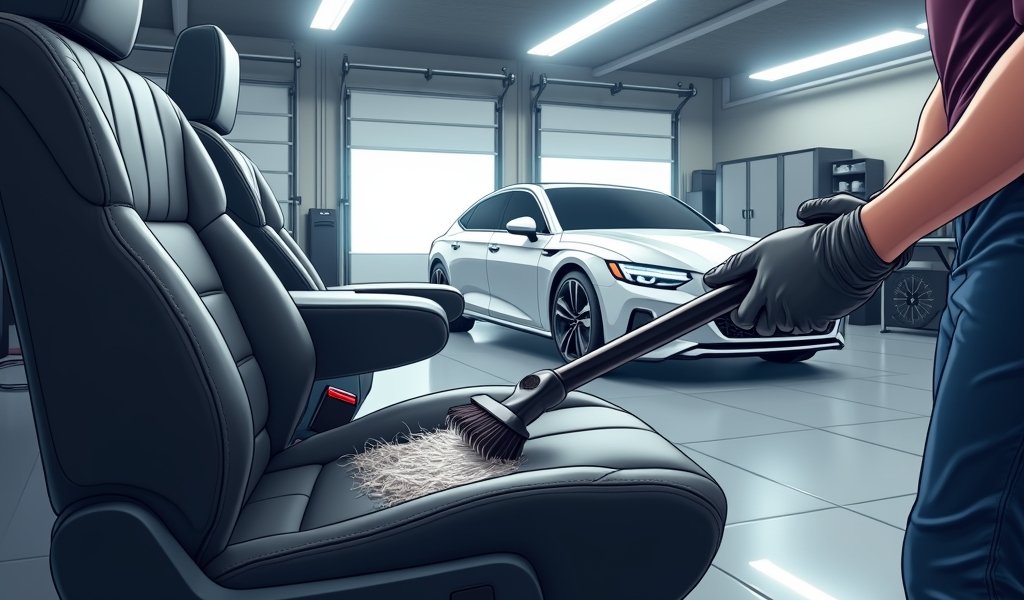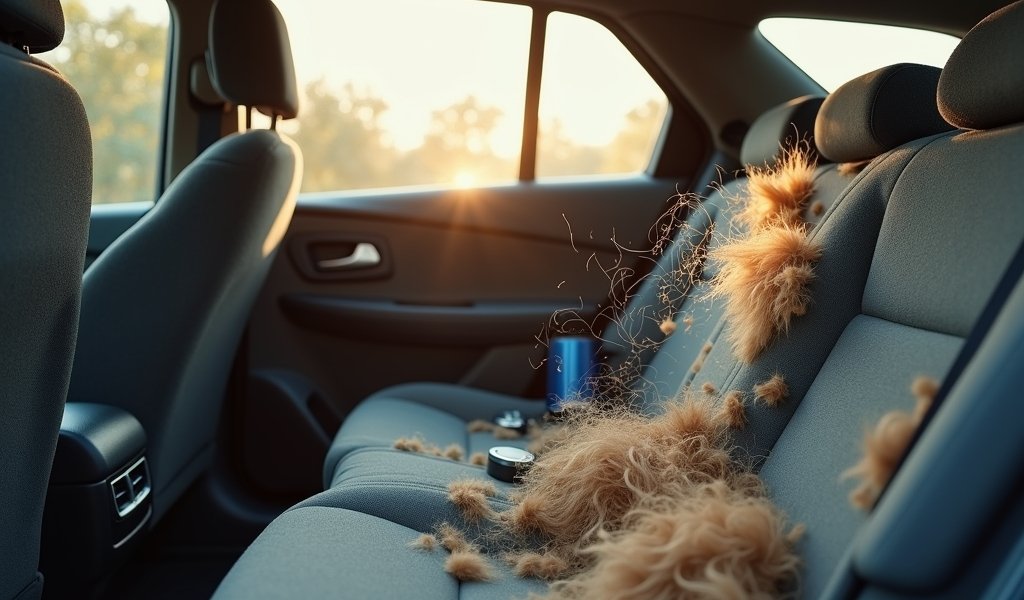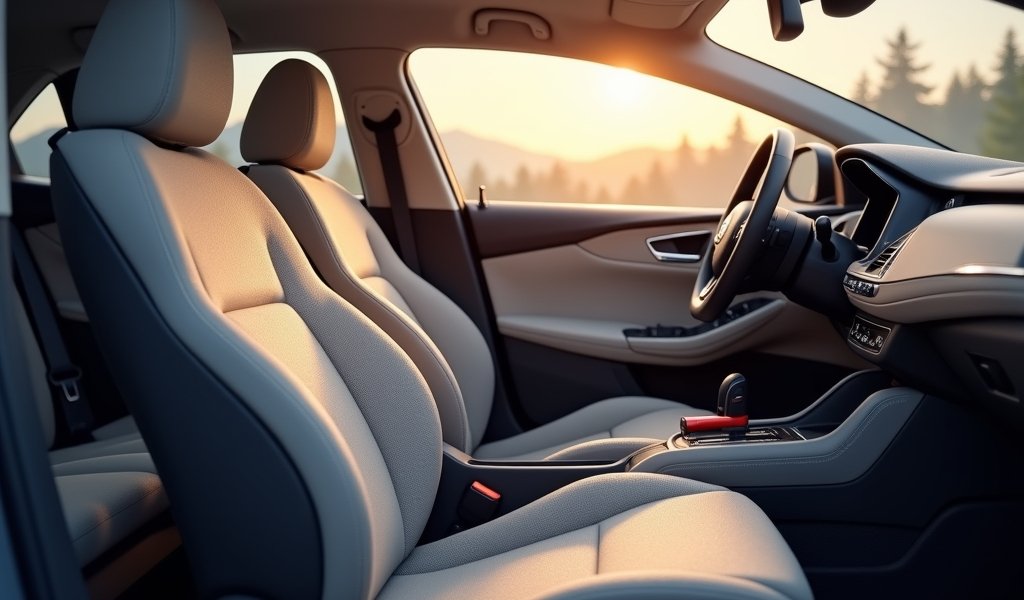Overview
This article presents five effective pet hair removal methods for car seats including rubber gloves, fabric softener spray, pumice stones, balloon static electricity, and specialized tools, along with prevention strategies to minimize future buildup. The techniques work by addressing the static electricity and hook-like properties that make pet hair particularly stubborn, offering solutions for different upholstery types and shedding situations.
Table of Contents
- Introduction to Pet Hair Removal from Car Seats
- Understanding Why Pet Hair Is So Difficult to Remove
- Hack #1: Rubber Gloves – Your Secret Weapon
- Hack #2: The Miracle of Fabric Softener Spray
- Hack #3: Pumice Stones – Not Just for Feet
- Hack #4: Balloon Static Method
- Hack #5: Specialized Pet Hair Removal Tools
- Preventing Pet Hair Buildup in Your Car
- Conclusion
- Frequently Asked Questions
Introduction to Pet Hair Removal from Car Seats
Ever slid into your car only to find yourself covered in what seems like your pet’s entire winter coat? You’re not alone. As a mechanic who’s spent over 15 years detailing vehicles, I’ve seen countless cars transformed into mobile pet salons. That stubborn pet hair that clings to your car seats like it’s holding on for dear life isn’t just annoying—it’s also remarkably persistent.
When Fido or Fluffy hitches a ride, they leave behind a calling card that standard vacuuming often can’t fully address. Those tiny hairs weave themselves into upholstery fibers, creating a fuzzy puzzle that can seem impossible to solve. But don’t worry—your car isn’t doomed to become a permanent fur repository.
In this comprehensive guide to pet hair removal from car seats, I’m sharing five professional-grade hacks that will have your interior looking showroom-ready again. These methods don’t require expensive equipment or professional services—just a bit of elbow grease and some surprisingly effective household items you probably already own.
Let’s transform your furry situation into a distant memory. Your car’s upholstery is about to breathe a sigh of relief.
Understanding Why Pet Hair Is So Difficult to Remove
Before diving into our removal hacks, it helps to understand what we’re up against. Pet hair isn’t just loose strands sitting on your upholstery—it’s a sophisticated opponent with some frustrating characteristics.
Pet hair contains microscopic scales along the shaft that act like tiny hooks. These scales open up when they come in contact with fabric fibers, creating a locking mechanism that’s surprisingly effective. It’s as if each hair is equipped with Velcro-like properties, designed specifically to cling to your car’s upholstery.
Additionally, static electricity plays a significant role in this annoying phenomenon. Your car’s interior, especially if it has synthetic upholstery, generates static electricity that essentially magnetizes pet hair to the surfaces. This electromagnetic attraction means that even after vacuuming, hairs can remain stubbornly attached.
Different upholstery materials present different challenges too. Cloth seats with their woven texture create countless tiny crevices where hair can hide. Leather and vinyl seats might seem easier to clean, but the static charge they develop can make hair cling just as persistently. According to a study on static electricity in fabrics, synthetic materials in car upholstery can retain a static charge for hours, continuously attracting loose hair.
Understanding these mechanisms helps explain why your regular vacuum might not be cutting it. Now let’s explore some solutions that specifically address these challenging properties.

Hack #1: Rubber Gloves – Your Secret Weapon
The first hack might surprise you with its simplicity and effectiveness. Those yellow rubber gloves hiding under your kitchen sink are about to become your car detailing best friend.
Here’s how to use rubber gloves for pet hair removal:
- Put on a pair of household rubber gloves—the kind you’d use for washing dishes.
- Slightly dampen the gloves with water (not soaking wet, just slightly moist).
- Run your gloved hand over the upholstery in one direction, applying gentle pressure.
- Watch in amazement as the pet hair collects into clumps that you can easily pick up.
The science behind this hack is fascinating. The rubber material creates the perfect amount of friction against the fabric, loosening the hair’s grip on the fibers. Meanwhile, the slight dampness helps neutralize some of the static electricity that makes hair cling so stubbornly.
I’ve used this technique in countless vehicles, and it works remarkably well on cloth upholstery. For particularly stubborn areas, try spraying a tiny amount of water directly onto the surface first. The moisture breaks the static bond and makes the rubber glove even more effective.
What I love about this hack is that it costs next to nothing. No special equipment required—just gloves you likely already have. It’s perfect for quick touch-ups when you notice your furry friend has left their mark after a trip to the dog park or vet.
This method is gentle enough that it won’t damage your upholstery but effective enough to make a noticeable difference in minutes. It’s the perfect starting point in your DIY car detailing arsenal for pet owners.
Hack #2: The Miracle of Fabric Softener Spray
Our second hack introduces a surprising ally in the battle against pet hair: fabric softener. This laundry staple works wonders on car upholstery for reasons that make perfect sense once you understand the science.
To create your fabric softener spray solution:
- Mix one part fabric softener with three parts water in a spray bottle
- Shake well to combine the solution
- Lightly mist the affected upholstery (don’t soak it!)
- Wait approximately 5 minutes for the solution to work its magic
- Wipe or brush the area with a microfiber cloth or soft brush
Fabric softener works by reducing static electricity—the very force that makes pet hair cling so stubbornly to your car seats. When sprayed on upholstery, it breaks the electrostatic bond between the hair and the fabric fibers. The hair simply loses its grip and can be easily wiped away.
I discovered this technique after noticing how much easier it was to remove pet hair from clothes fresh out of the dryer with fabric softener sheets. The principle is identical, but the spray form gives you more control and prevents over-saturating your car’s upholstery.
One important caution: this method works best on fabric upholstery. If you have leather seats, you’ll want to use a solution specifically designed for leather to avoid damage. The fabric softener chemicals, while gentle enough for cloth, can potentially dry out and damage leather surfaces over time.
This hack is particularly effective for those embedded hairs that seem to have taken up permanent residence in your car’s upholstery. It’s like giving eviction notices to each and every strand!
Hack #3: Pumice Stones – Not Just for Feet
When I first recommend pumice stones to my clients for pet hair removal, I’m often met with skeptical looks. Yes, the same volcanic rock used for smoothing calluses has a secret talent for collecting pet hair that borders on magical.
Pet hair removal pumice stones are slightly different from bathroom pumice stones. They’re specifically designed for fabric and won’t damage your upholstery. You can find them at pet stores or online retailers, usually marketed as “pet hair removers.”
Here’s how to use this geological wonder effectively:
- Gently rub the pumice stone across your car’s upholstery in one direction
- Work in small sections, moving methodically across each seat
- The hair will collect into manageable clumps
- Remove the clumps by hand or with a vacuum
- Clean the pumice stone periodically to remove collected hair
The slightly rough texture of the pumice creates just enough friction to grab pet hair without damaging the fabric fibers. It works by catching hair in its microscopic pores while simultaneously lifting it from the upholstery. According to The American Chemical Society, pumice’s unique porous structure makes it ideal for this purpose.
I’ve found pumice stones particularly effective on deeply embedded hair in plush upholstery—the kind that seems to have formed a permanent bond with your car seats. While the rubber glove method works well for surface hair, pumice stones excel at extracting those stubborn, woven-in strands.
A word of caution: always test this method on an inconspicuous area first. While pet hair removal pumice stones are designed to be gentle, some delicate fabrics might be sensitive to the friction. That said, I’ve rarely encountered issues when using appropriate pet-specific pumice products.
Hack #4: Balloon Static Method
Sometimes fighting fire with fire is the best approach. In this case, we’re fighting static with static in what might be the most entertaining pet hair removal method you’ll ever try.
The balloon static method sounds like a party trick, but it’s actually based on solid scientific principles:
- Inflate a balloon to a comfortable size
- Rub the balloon against your hair or on a wool fabric to create static electricity
- Hover the charged balloon just above the pet hair-covered surface
- Watch as the hair literally jumps from the upholstery to the balloon
Here’s the science: when you rub the balloon, you create a negative charge on its surface. Pet hair, when sitting on your car upholstery, typically carries a positive charge. As we all learned in science class, opposite charges attract. The negatively charged balloon attracts the positively charged hair, pulling it away from the upholstery.
This hack works best on shorter pet hair and in dry conditions (humidity reduces static effectiveness). It’s particularly useful for those final stubborn hairs that other methods miss. I often use this as a finishing touch after more thorough cleaning methods.
The balloon method has another advantage: it’s completely gentle on your upholstery since there’s no physical contact between the balloon and the fabric. For delicate materials or vintage car interiors, this can be a safer option than more abrasive approaches.
While it might look silly (and yes, I’ve gotten some strange looks from clients when demonstrating this technique), the results speak for themselves. Just be prepared for some curious glances if you’re doing this in a public parking lot!

Hack #5: Specialized Pet Hair Removal Tools
When all else fails—or when you’re dealing with a particularly hairy situation—it’s time to call in the specialized equipment. The market is flooded with tools designed specifically for pet hair removal, but not all are created equal. As someone who’s tested dozens of these products in professional settings, I can tell you which ones are worth your money.
The most effective specialized tools include:
- Pet hair removal brushes with rubber bristles
- Electrostatic pet hair sponges
- Lint rollers with extra-sticky sheets designed for pet hair
- Specialized pet hair vacuum attachments
Rubber bristle brushes work on principles similar to our rubber glove hack but with the advantage of firmer bristles that can reach deeper into upholstery fibers. These brushes create friction against the fabric, loosening hair while the rubber material helps attract and collect it.
Electrostatic sponges use charged particles to attract hair—similar to the balloon method but in a more practical, everyday tool. They’re reusable and don’t require any preparation, making them perfect for quick cleanups.
If you’re committed to keeping your car hair-free, investing in a high-quality vacuum for car detailing with pet hair attachments is worth considering. These specialized attachments usually feature rubber components that agitate the hair while the vacuum suction removes it.
For the most stubborn situations—like when your Great Pyrenees decided your backseat was the perfect shedding spot—sometimes combining methods works best. I often start with a rubber brush to loosen and collect hair, follow with the fabric softener spray on any resistant areas, and finish with a good vacuuming.
While specialized tools require an investment, they can save significant time and frustration, especially for multiple-pet households or breeds that shed extensively.
Preventing Pet Hair Buildup in Your Car
An ounce of prevention is worth a pound of cure—especially when that cure involves picking individual dog hairs out of your car’s upholstery. Let’s talk about strategies to minimize pet hair problems before they start.
The most effective preventive measures include:
- Using seat covers specifically designed for pets
- Regular brushing of your pet before car trips
- Creating a designated pet area in your vehicle
- Quick clean-ups after each pet transport
Pet-specific seat covers are a game-changer for frequent furry travelers. Look for covers made from tightly woven, water-resistant materials that hair doesn’t easily stick to. Many modern options are designed to be easily removed and machine washed, making maintenance simple.
Brushing your pet thoroughly before they enter your vehicle can dramatically reduce shedding during the journey. This is especially important during seasonal shedding periods. Just five minutes with a good brush can prevent hours of cleaning later.
Creating a designated pet zone in your vehicle helps contain hair to one area. This might mean always having your pet travel in the cargo area (for SUVs) or using a barrier to keep them on one seat only. Containment makes regular maintenance much more manageable.
The “clean as you go” approach works wonders. Keep a lint roller or pet hair removal brush in your glove compartment for quick touch-ups immediately after dropping Fido at doggy daycare. Fresh hair is much easier to remove than hair that has had time to work its way into the upholstery.
Finally, consider the fabric of your next vehicle if you’re a pet owner. Leather and vinyl upholstery, while sometimes more expensive, are significantly easier to keep pet-hair free than cloth seats. The investment might save you countless hours of cleaning over the vehicle’s lifetime.
With these preventive strategies and our five removal hacks, you’ll be well-equipped to maintain a car interior that doesn’t broadcast your pet ownership status to every passenger. Detailing your car interior like a pro becomes much easier when you’re not fighting an uphill battle against pet hair.
Conclusion
Pet hair in your car doesn’t have to be a permanent fixture or a source of endless frustration. With these five professional-grade hacks—rubber gloves, fabric softener spray, pumice stones, the balloon static method, and specialized tools—you now have a comprehensive arsenal against even the most stubborn fur deposits.
Remember that different techniques work better for different situations and upholstery types. Don’t be afraid to combine methods or experiment to find what works best for your specific vehicle and pet. Sometimes the rubber glove method followed by a quick balloon static cleanup provides the perfect one-two punch.
The key to maintaining a hair-free car interior is consistency. Regular cleaning prevents buildup that becomes more difficult to address over time. A quick five-minute cleanup after each pet transport can save you from needing a full hour-long detailing session later.
Your car can be both pet-friendly and presentable. With these techniques, you don’t have to choose between bringing your furry family members along for the ride and maintaining a clean, professional-looking vehicle interior.
Next time someone compliments your spotless car interior despite knowing you have three shedding dogs at home, you can smile knowingly. You’ve mastered the art of pet hair removal—a skill that makes both your human and furry passengers more comfortable on every journey.
Frequently Asked Questions
How often should I clean pet hair from my car seats?
For regular pet travelers, a quick cleanup after each trip prevents buildup. Perform a more thorough cleaning weekly if your pet rides with you frequently.
Will pet hair removal methods damage leather car seats?
Most gentle methods like rubber gloves and balloons are safe for leather. Avoid fabric softener sprays and pumice stones on leather upholstery as they can cause drying and scratches.
What’s the fastest way to remove pet hair in a hurry?
Rubber gloves or a pet hair removal brush provide the quickest results for emergencies. They require no preparation and can transform a hair-covered seat in minutes.
Do car vacuums actually work for pet hair?
Standard car vacuums struggle with embedded pet hair. Specialized vacuums with rubber or brush attachments designed for pet hair are significantly more effective.
How can I remove pet odor along with the hair?
After removing hair, sprinkle baking soda on seats, let sit for 15-20 minutes, then vacuum. For persistent odors, enzyme-based pet odor eliminators target the source of smells.
Published by Michael Rodriguez, Master Automotive Detailer with 15 years of experience in vehicle interior restoration. September 2023.

